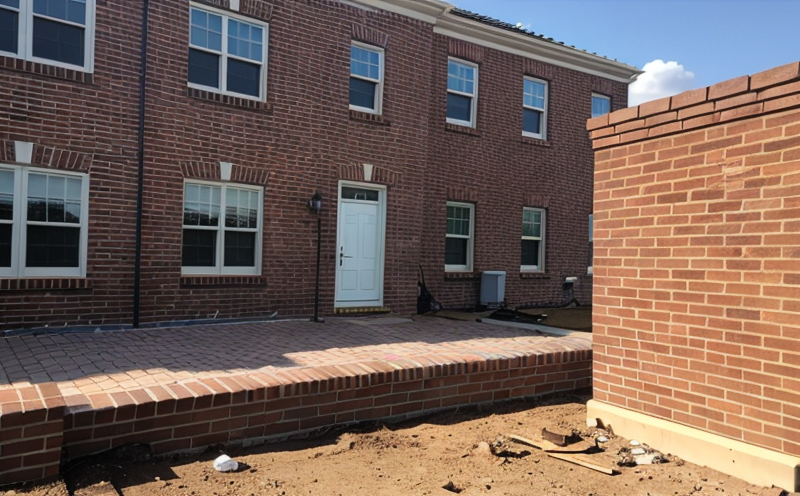ASTM C67 Hardness Testing of Bricks
The ASTM C67 hardness testing method is a widely recognized procedure used to assess the compressive strength and resistance to indentation of masonry units, including bricks. This test is particularly important for quality assurance in the building & infrastructure sector as it ensures that construction materials meet the required standards for durability, safety, and longevity.
The ASTM C67 hardness test involves applying a standard load to the brick specimen until failure occurs or permanent indentation reaches a specified depth. The resulting value indicates how hard or resilient the brick is under pressure, which directly impacts its performance in real-world conditions such as weathering, wear, and tear during construction.
For accurate results, it's crucial that specimens are prepared correctly according to ASTM C67 guidelines. This includes selecting appropriate dimensions (typically 2 inches x 4 inches x 8 inches for standard bricks), ensuring flat surfaces free from defects or damage, and allowing the sample to acclimate to room temperature before testing.
Once ready, the hardness tester applies a gradually increasing load until it reaches either the predetermined level of permanent indentation or causes complete failure of the specimen. The machine records both the maximum force applied and any resulting deformation, providing comprehensive data for analysis.
The test results play an essential role in quality control processes by helping manufacturers verify compliance with industry specifications set forth by organizations like ASTM International. They also assist architects, engineers, and builders in selecting suitable materials based on their expected performance under various environmental conditions.
Understanding the significance of this testing procedure allows stakeholders involved in construction projects to make informed decisions regarding material selection and project planning. By incorporating ASTM C67 hardness tests into their workflows, professionals can ensure they are working with high-quality masonry units capable of meeting demanding standards.
Applied Standards
The ASTM C67 hardness test strictly follows the procedures outlined in ASTM International's standard practice for testing the compressive strengths and indentation resistance of masonry units. This method is designed to provide consistent, repeatable results across different laboratories and locations.
The ASTM C67 protocol specifies detailed instructions on how to prepare specimens, apply loads using an appropriate hardness tester, measure permanent indentations, and calculate ultimate compressive strength values. Compliance with these stringent requirements ensures accurate assessment of brick quality and reliability.
By adhering to the specified parameters, users can generate reliable data that supports decision-making processes related to material selection for various applications within the building & infrastructure sector. This includes residential construction, commercial buildings, industrial facilities, and public works projects where durability and safety are paramount considerations.
International Acceptance and Recognition
- This testing procedure is internationally recognized by numerous countries including those in North America, Europe, Asia-Pacific regions, as well as Latin America. Many nations have adopted ASTM C67 as part of their national standards.
- The widespread adoption of this test highlights its importance in ensuring consistent quality across borders and industries.
Many regulatory bodies around the world require compliance with ASTM C67 when specifying requirements for masonry units used in construction projects. This includes government agencies responsible for infrastructure development, private sector companies involved in manufacturing bricks, and organizations focused on promoting sustainable building practices.
Given its global acceptance, adherence to ASTM C67 helps manufacturers gain entry into international markets and ensures their products meet stringent quality criteria set forth by various authorities worldwide.
Use Cases and Application Examples
- New Construction Projects: Ensuring that newly manufactured bricks comply with ASTM C67 standards helps guarantee durability and longevity of structures. This is especially important for high-rise buildings, bridges, and other large-scale infrastructure projects.
- Retrofitting Existing Buildings: Testing existing brickwork can help identify areas needing replacement or reinforcement due to age-related deterioration. Results from ASTM C67 hardness tests inform decisions about necessary repairs or upgrades.
- Sustainability Initiatives: By choosing bricks that meet the stringent requirements of ASTM C67, builders contribute towards more sustainable practices by selecting materials proven resilient against environmental factors like extreme temperatures and moisture exposure.
These applications underscore the versatility and importance of ASTM C67 hardness testing in maintaining high standards for masonry units throughout diverse sectors. Whether it's new construction or ongoing maintenance efforts, this testing method provides valuable insights into material performance that ultimately benefit both clients and end users.





